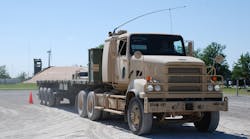Manager: Robert Ahlers
Title: Captain, U.S. Army Reserve
Fleet: 1483rd Transportation Company
Operation: 60 M915A5 tractors, 120 flatbed trailers, 30 support vehicles
Problem:
Vehicle uptime is a critical metric for any motor carrier, but it’s doubly important in the U.S. Army as trucks on the side of the road mean soldiers don’t get resupplied with food, fuel, weapons, ammunition, medical supplies, or whatever else they might need to remain in proper fighting trim.
That’s why anything and everything associated with vehicle maintenance is closely watched by transportation company commanders. And Capt. Robert Ahlers, who headed up the Ohio National Guard’s 1483rd Transportation Company for two years, can attest to that.
“If we’re out on a mission and a truck goes down, we’ve got to get it back on the road ourselves and as quickly as possible,” he explains. “If we don’t have our wrecker with us, there are tow bars on each of our trucks so one of our tractors can do the job.”
Yet only about 26 out of the typical complement of 170 to 180 soldiers in a transportation company are designated as “maintainers.” While several of these maintainers are always detailed to accompany a convoy in a wrecker or five-ton support truck loaded with spare parts and other repair gear, they can’t be everywhere at every moment.
Solution:
As a result, drivers in transportation companies conduct many maintenance duties that are typically left in the hands of mechanics and technicians in the civilian trucking world. For example, Ahlers notes that out of the 16 hours the designated drivers in the 1483rd spend in uniform, four of those hours are blocked off one weekend per month for preventive maintenance updates and refreshers on pre- and post-trip inspections.
“They go out with our maintainers to pull off tires, inspect engines, and observe repairs,” he says. “We task our drivers with a lot of responsibility when it comes to the upkeep of our equipment.”
Ahlers adds that the 3- to 4-in.-thick operating manual for the unit’s M915A5 tractors is gone over with a fine-tooth comb by the 1483rd’s drivers. The vehicles are basically Western Star models equipped with a 500-hp. Detroit engine, 6-speed Allison automatic transmission, and forward collision radar.
“Before every mission, [drivers] spend at least 30 to 40 minutes closely inspecting their tractors and trailers, and it’s their responsibility to ensure fluid levels are topped off and the like,” Ahlers says. “If they spot anything amiss, we’ve got a four-bay shop they can route their equipment into.”
The 1483rd is a cargo-carry unit that straps military supplies on its all-purpose flatbeds. Equipped with Teflon-coated fifth wheels to make flatbed hitching and unhitching easier, the 1483rd’s tractor-trailers can haul up to 120,000 lbs. where legal, are governed at a maximum speed of 65 mph, and sport central tire inflation systems to help further minimize downtime on the road.
“If we go into sand or snow, our drivers can adjust tire inflation on the fly to cope with such conditions quickly so they can stay focused on completing their mission,” Ahlers explains.
The M915A5 can also be “up armored” if sent into combat zones and though it sports what looks like a sleeper compartment, it’s actually extra storage space for rucksacks, weapons, and other personal gear.
Such sticklers for detail are the 1483rd’s drivers that when they competed in the National Truck Driving Championships earlier this year, they found themselves losing points because they took far longer to conduct vehicle pre- and post-trip inspections than their civilian counterparts.
“They are so used to doing things the long way that the 10-minute limit put them off,” Ahlers says. “But they conduct very rigorous pre-trip inspections for a simple reason: There’s little to no margin for error when we’re deployed on a mission.”



